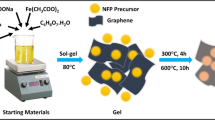Abstract
With an aim to enhance the thermal stability and electrolyte wetting of a polyethylene porous separator, an Al2O3 nano-powder layer and an electro-spun PVdF nanofiber layer were successively formed on both sides of the polyethylene separator. The Al2O3 layer provides excellent thermal stability as indicated by thermal shrinkage of only 7.8 % in area at 180 °C and absence of a meltdown up to 200 °C. The electrolyte uptake of the multilayer separator was increased with the thickness of the nanofiber layer. As a result, discharge capacity, rate capability, and cycle life of the lithium ion batteries employing the PVdF nanofiber layers were improved, overcompensating for a loss of performance caused by the Al2O3 layer. Therefore, the multilayer approach is highly effective in improving both the performance and safety of lithium ion batteries.









Similar content being viewed by others
References
Yang M, Hou J (2012) Membranes in lithium ion batteries. Membr 2:367–383
Ritchie A, Howard W (2006) Recent developments and likely advances in lithium-ion batteries. J Power Sources 162:809–812
Huang X (2011) Separator technologies for lithium-ion batteries. J Solid State Electrochem 15:649–662
Zhang SS (2007) A review on the separators of liquid electrolyte Li-ion batteries. J Power Sources 164:351–364
Kim KJ, Kim JH, Park MS, Kwon HK, Kim H, Kim YJ (2012) Enhancement of electrochemical and thermal properties of polyethylene separators coated with polyvinylidene fluoride–hexafluoropropylene co-polymer for Li-ion batteries. J Power Sources 198:298–302
Lee YM, Kim JW, Choi NS, Lee JA, Seol WH, Park JK (2005) Novel porous separator based on PVdF and PE non-woven matrix for rechargeable lithium batteries. J Power Sources 139:235–241
Pu W, He X, Wang L, Jiang C, Wan C (2006) Preparation of PVDF–HFP microporous membrane for Li-ion batteries by phase inversion. J Membr Sci 272:11–14
Song JC, Ryou MH, Son BK, Lee JN, Lee DJ, Lee YM, Choi JW, Park JK (2012) Co-ployimide coated polyethylene separators for enhanced thermal stability of lithium ion batteries. Electrochim Acta 85:524–530
Jeong HS, Kim DW, Jeong YU, Lee SY (2010) Effect of phase inversion on microporous structure development of Al2O3/poly(vinylidene fluoride-hexafluoropropylene)-based ceramic composite separators for lithium-ion batteries. J Power Sources 195:6116–6121
Park JH, Park W, Kim JH, Ryoo DJ, Kim HS, Jeong YU, Kim DW, Lee SY (2010) Close-packed poly(methyl methacrylate) nanoparticle arrays-coated polyethylene separators for high-power lithium-ion polymer batteries. J Power Sources 196:7035–7038
Huang X (2011) Development and characterization of a bilayer separator for lithium ion batteries. J Power Sources 196:8125–8128
Kim KM, Park NG, Ryu KS, Chang SH (2006) Characteristics of PVdF-HFP/TiO2 composite membrane electrolytes prepared by phase inversion and conventional casting methods. Electrochim Acta 51:5636–5644
Huang X, Hitt J (2013) Lithium ion battery separators: development and performance characterization of a composite membrane. J Membr Sci 425–426:163–168
Zhang SS, Xu K, Jow TR (2005) An inorganic composite membrane as the separator of Li-ion batteries. J Power Sources 140:361–364
Li Z, Su G, Wang X, Gao D (2005) Micro-porous P(VDF-HFP)-based polymer electrolyte filled with Al2O3 nanoparticles. Solid State Ionics 176:1903–1908
Xiang H, Chen J, Li Z, Wang H (2011) An inorganic membrane as a separator for lithium-ion battery. J Power Sources 196:8651–8655
Choi JA, Kim SH, Kim DW (2010) Enhancement of thermal stability and cycling performance in lithium-ion cells through the use of ceramic-coated separators. J Power Sources 195:6192–6196
Jeong HS, Hong SC, Lee SY (2010) Effect of microporous structure on thermal shrinkage and electrochemical performance of Al2O3/poly(vinylidene fluoride-hexafluoropropylene) composite separators for lithium-ion batteries. J Membr Sci 364:177–182
Kim M, Han GY, Yoon KJ, Park JH (2010) Preparation of a trilayer separator and its application to lithium-ion batteries. J Power Sources 195:8302–8305
Kim M, Park JH (2012) Inorganic thin layer coated porous separator with high thermal stability for safety reinforced Li-ion battery. J Power Sources 212:22–27
Yi W, Huaiyu Z, Jian H, Yun L, Shushu Z (2009) Wet-laid non-woven fabric for separator of lithium-ion battery. J Power Sources 189:616–619
Jeong HS, Choi ES, Lee SY (2012) Composition ratio-dependent structural evolution of SiO2/poly(vinylidene fluoride-hexafluoropropylene)-coated poly(ethylene terephthalate) nonwoven composite separators for lithium-ion batteries. Electrochim Acta 86:317–322
Lee JR, Won JH, Kim JHm Kin KJ, Lee SY (2012) Evaporation-induced self-assembled silica colloidal particle-assisted nanoporous structural evolution of poly(ethylene terephthalate) nonwoven composite separators for high-safety/high-rate lithium-ion batteries. J Power Sources 216:42–47
Cho TH, Tanaka M, Onishi H, Kondo Y, Nakamura T, Yamazaki H, Tanase S, Sakai T (2008) Battery performances and thermal stability of polyacrylonitrile nanofiber-based nonwoven separators for Li-ion battery. J Power Sources 181:155–160
Yang C, Jia Z, Guan Z, Wang L (2009) Polyvinylidene fluoride membrane by novel electrospinning system for separator of Li- ion batteries. J Power Sources 189:716–720
Jung HR, Ju DH, Lee WJ, Zhang X, Kotek R (2009) Electrospun hydrophilic fumed silica/polyacrylonitrile nanofiber-based composite electrolyte membranes. Electrochim Acta 54:3630–3637
Hwang KH, Kwon BM, Byun HS (2011) Preparation of PVdF nanofiber membranes by electrospinning and their use as secondary battery separators. J Membr Sci 378:111–116
Lasia A (2009) Modern aspects of electrochemistry no. 43. Springer, NewYork
Author information
Authors and Affiliations
Corresponding authors
Rights and permissions
About this article
Cite this article
An, MY., Kim, HT. & Chang, DR. Multilayered separator based on porous polyethylene layer, Al2O3 layer, and electro-spun PVdF nanofiber layer for lithium batteries. J Solid State Electrochem 18, 1807–1814 (2014). https://doi.org/10.1007/s10008-014-2412-4
Received:
Revised:
Accepted:
Published:
Issue Date:
DOI: https://doi.org/10.1007/s10008-014-2412-4




